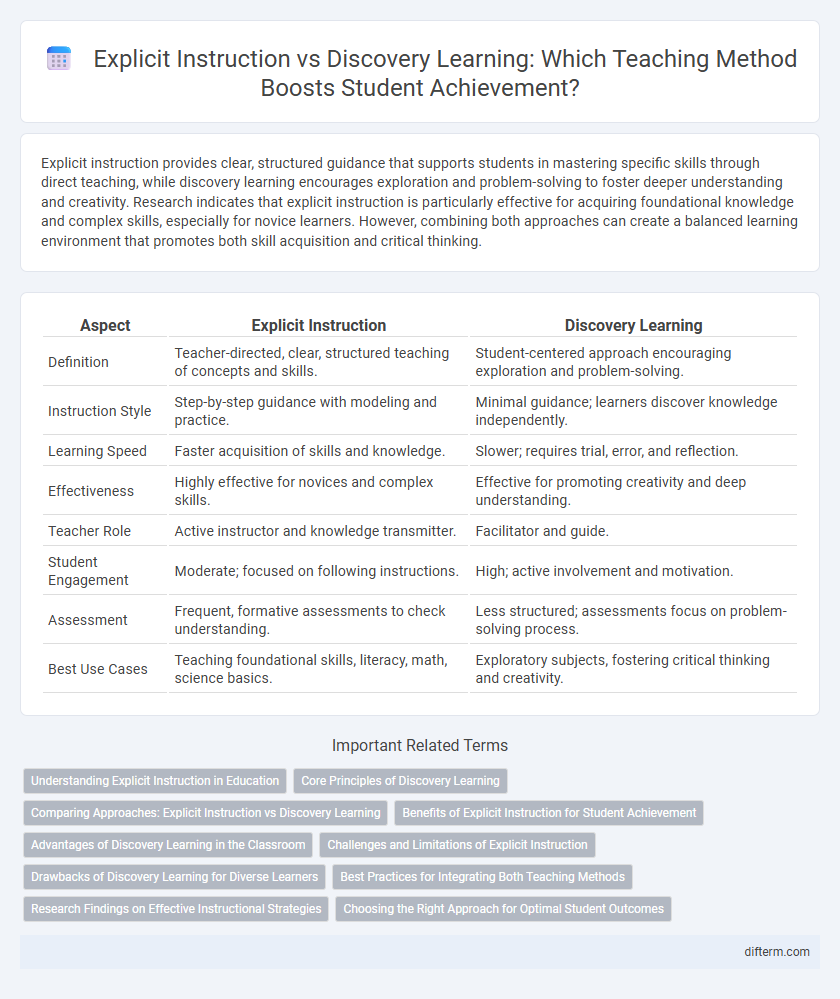Explicit instruction provides clear, structured guidance that supports students in mastering specific skills through direct teaching, while discovery learning encourages exploration and problem-solving to foster deeper understanding and creativity. Research indicates that explicit instruction is particularly effective for acquiring foundational knowledge and complex skills, especially for novice learners. However, combining both approaches can create a balanced learning environment that promotes both skill acquisition and critical thinking.
Table of Comparison
| Aspect | Explicit Instruction | Discovery Learning |
|---|---|---|
| Definition | Teacher-directed, clear, structured teaching of concepts and skills. | Student-centered approach encouraging exploration and problem-solving. |
| Instruction Style | Step-by-step guidance with modeling and practice. | Minimal guidance; learners discover knowledge independently. |
| Learning Speed | Faster acquisition of skills and knowledge. | Slower; requires trial, error, and reflection. |
| Effectiveness | Highly effective for novices and complex skills. | Effective for promoting creativity and deep understanding. |
| Teacher Role | Active instructor and knowledge transmitter. | Facilitator and guide. |
| Student Engagement | Moderate; focused on following instructions. | High; active involvement and motivation. |
| Assessment | Frequent, formative assessments to check understanding. | Less structured; assessments focus on problem-solving process. |
| Best Use Cases | Teaching foundational skills, literacy, math, science basics. | Exploratory subjects, fostering critical thinking and creativity. |
Understanding Explicit Instruction in Education
Explicit instruction employs clear, direct teaching methods that emphasize step-by-step guidance and active student engagement, ensuring mastery of foundational skills. Research in education shows that explicit instruction significantly improves student achievement, especially in literacy and mathematics, by minimizing misconceptions and cognitive overload. This structured approach contrasts with discovery learning, offering more consistent outcomes through systematic modeling, practice, and feedback.
Core Principles of Discovery Learning
Discovery learning emphasizes active engagement, where learners construct knowledge through exploration and problem-solving, promoting deeper understanding. Core principles include fostering intrinsic motivation, encouraging hypothesis testing, and supporting learners in making connections between concepts. This approach contrasts with explicit instruction by prioritizing learner-driven inquiry over direct teacher-led demonstrations.
Comparing Approaches: Explicit Instruction vs Discovery Learning
Explicit instruction emphasizes clear, direct teaching of specific skills and concepts through structured lessons, enabling efficient knowledge acquisition and immediate feedback. Discovery learning encourages students to explore, experiment, and construct understanding independently, fostering critical thinking and problem-solving skills but often requiring more time and guidance. Research highlights that explicit instruction yields higher achievement in foundational skills, while discovery learning supports deeper conceptual understanding and creativity when appropriately scaffolded.
Benefits of Explicit Instruction for Student Achievement
Explicit instruction enhances student achievement by providing clear, structured guidance that helps learners grasp concepts efficiently and reduces cognitive overload. Research shows that explicit teaching methods improve retention and comprehension, particularly for struggling students and those with learning disabilities. This approach fosters mastery of foundational skills, enabling students to build more complex knowledge confidently.
Advantages of Discovery Learning in the Classroom
Discovery learning enhances student engagement by promoting active exploration and critical thinking, leading to deeper understanding and retention of concepts. It fosters creativity and problem-solving skills as learners construct knowledge through hands-on experiences and inquiry-based activities. This approach supports differentiated learning by allowing students to progress at their own pace and encourages intrinsic motivation through autonomy in the educational process.
Challenges and Limitations of Explicit Instruction
Explicit instruction faces challenges such as limited student engagement and reduced opportunities for critical thinking, which may hinder deeper conceptual understanding. The structured nature often restricts creativity and problem-solving skills development by emphasizing rote memorization over exploration. Furthermore, this method may not effectively address diverse learning styles, potentially widening achievement gaps among students with varying needs.
Drawbacks of Discovery Learning for Diverse Learners
Discovery learning can present significant challenges for diverse learners, including those with varying cognitive abilities, language proficiency, or learning disabilities, as it relies heavily on self-guided exploration and problem-solving without structured guidance. This approach may increase frustration and cognitive overload, resulting in decreased comprehension and academic performance among students who require clear, step-by-step instruction. Studies show that explicit instruction provides a more equitable learning environment by offering clear objectives, scaffolding, and immediate feedback, which are crucial for addressing the needs of diverse learners.
Best Practices for Integrating Both Teaching Methods
Balancing explicit instruction and discovery learning enhances student comprehension and engagement by combining direct teaching of foundational concepts with opportunities for exploration and critical thinking. Effective integration involves scaffolding discovery tasks with clear objectives and guided prompts while reinforcing key skills through direct instruction to support diverse learning styles. Educators maximize outcomes by alternating structured lessons with inquiry-based activities, promoting both mastery and creativity in the classroom.
Research Findings on Effective Instructional Strategies
Research findings indicate that explicit instruction, characterized by clear, structured teaching and guided practice, consistently leads to higher student achievement compared to discovery learning, which relies on student exploration and minimal teacher guidance. Studies show explicit instruction enhances comprehension, skill acquisition, and retention, particularly for complex or new material. Meta-analyses confirm that direct teaching methods outperform discovery learning in speed and depth of learning across various subjects and grade levels.
Choosing the Right Approach for Optimal Student Outcomes
Explicit instruction, characterized by clear, structured teaching and guided practice, effectively supports skill mastery and knowledge retention, especially for complex or foundational concepts. Discovery learning, which encourages student exploration and problem-solving, fosters critical thinking and creativity but may require more scaffolding to ensure comprehension. Selecting the optimal approach depends on factors such as student proficiency, learning objectives, and content complexity to maximize engagement and academic achievement.
explicit instruction vs discovery learning Infographic

 difterm.com
difterm.com